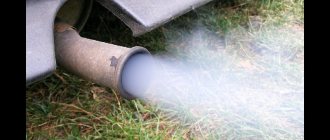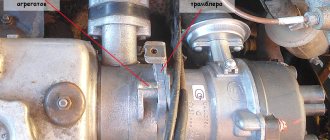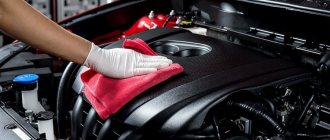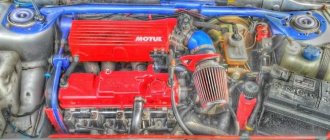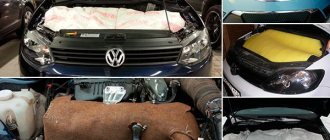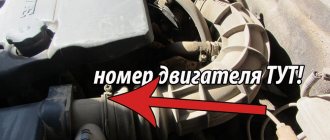Signs of burnt valves
One of the main signs of a burnt-out valve is the engine tripping, which also indicates other problems not related to the valves, the elimination of which is cheaper and easier to repair. In addition to engine tripping, engine power decreases and fuel consumption increases.
The main indicator of the presence of a malfunction in the engine is its tripping in all operating modes (for example, with a faulty spark plug, tripping of a warmed-up engine operating at high speeds may not be noticeable).
Causes of burnout
Valves burn out for various reasons, including:
No one is immune from purchasing defective and low-quality spare parts, so buy spare parts from trusted sellers who value their reputation. If the valves are adjusted incorrectly (they are tightly clamped), the engine operation will be noticeable by the characteristic “tractor” sound. In this case, due to non-compliance with the thermal clearance, the valve overheats, which will invariably lead to its burnout.
If the ignition is set incorrectly, combustion of the combustible mixture occurs when the valve is open and leads to its malfunction. A lean mixture is dangerous because the combustion temperature of the combustible mixture increases, which leads to overheating and burnout.
How to deal with the problem?
It is very easy to avoid this situation. Complete a technical inspection of the car in a timely manner; in case of any misunderstanding or unnecessary sounds in the engine area, be sure to have the car checked at a service station. In addition, constantly monitor the oil and antifreeze levels in your car. Timely engine diagnostics prevent engine malfunction.
Having problems with your car?
Turbo Diesel Service is ready to help with a variety of cases. All you have to do is contact the phone numbers provided or leave your number for feedback!
How to determine
Valve failure can be determined by several methods:
Video: Signs of valve burnout
Something else useful for you:
Instructions
How to determine valve burnout without special tools? In this manual, we will look at how to determine burnout without resorting to special tools and disassembling the engine (provided that the ignition and power systems are adjusted in accordance with the requirements and are not the cause of the trip).
In addition, you can determine a non-working spark plug by inspection. A faulty spark plug has the following external defects:
Having sufficient skills and tools, you can replace the valves yourself, but since this procedure is very responsible, complex and requires special tools and devices, it is better to entrust it to specialists.
If the engine fails, do not put off diagnosing the cause until later, even if the budget does not allow for repairs in the near future. It is necessary to identify the reason why the engine is unstable. And if this reason is not related to burnout of valves and wear of the cylinder-piston group, then the car can be operated in a gentle mode, which will lead to increased fuel consumption and the possibility of stalling at the wrong moment. But otherwise, it is better to stop using it to avoid higher repair costs.
Source
How to determine for yourself that the timing valve has burnt out
Valve burnout is a common problem in gasoline and diesel engines. This malfunction occurs both on relatively “fresh” engines and on power units with an impressive mileage. At the initial stage, it is extremely important to accurately determine the nature of the malfunction, since further operation of the engine with burnt valves greatly aggravates the consequences of such a breakdown and leads to expensive repairs.
Why do valves burn out?
Valves burnout occurs for various reasons. For engines that require periodic valve adjustment, valve burnout often occurs due to untimely adjustment of the valve thermal clearance. On engines with automatic adjustment of the specified gap, failure of hydraulic compensators also often leads to the valve burning out.
The main causes of engine valve burnout are:
A burnt-out valve can collapse at one moment, after which fragments of the valve fall into the engine cylinder. As a result, serious damage to the piston, cylinder head or cylinder head defects may occur. In the latter case, there is a risk that a large piece of the burnt valve will pierce the engine cylinder block, which is the actual destruction of not only the cylinder head and piston group, but also the cylinder block. In such a situation, prolonged operation of the engine with a burnt-out valve may lead to the need to replace the entire engine.
Why did the piston burn out?
Lean mixture
1 liter of gasoline contains more than 16 kg of oxygen. It does not burn very quickly, the motor overheats, the energy drops, and as a result the entire engine overheats. The piston is key in this list, because it is aluminum (if you do not take into account tuned pistons) and is located directly in the fuel combustion zone. As is well known, aluminum melts at about 660 °C, and when you consider that the maximum permissible engine temperature is only 150 degrees, and then no oil can lubricate 200 °C, it doesn’t take long to calculate that a lean mixture can still heat up the parts in the middle of the engine more than rather than 4 times more.
Bad gasoline
Fresh gasoline burns the piston for the same reason - as a result of overheating. Because the gasoline that we pour into our gas tank often cannot be called gasoline. Proper gasoline burns at a fairly low temperature, while expanding very intensely, because the essence of any gas driven to the top dead center (TDC) is that it expands to the maximum relative to its original volume, thereby pushing the piston downwards with the utmost convincing force, and combustion and the generated temperature are all side effects, without which the engine would do just fine. Bad gasoline, like normal gasoline, contains components such as benzene, gasoline and other bad substances. The fact is that they are contained in low-quality “gasolines” in completely different proportions, and in fact in larger proportions than the standards allow.
Determining valve burnout without removing the cylinder head
The first step is to determine which cylinder is not working. The testing methods are in many ways similar to diagnosing faulty spark plugs. To check, you should start the engine, after which, with the engine running at idle speed, you will need to remove the caps from the spark plugs one by one.
Then you need to unscrew the spark plug on the inoperative cylinder and replace it with a known good one, and also check the high-voltage armored wire of this cylinder for functionality. It would also be a good idea to check the ignition coil, etc. Subsequent starting of the engine will show whether the problem lies in the elements of the vehicle’s ignition system or whether further diagnostics are necessary.
Let's sum it up
Let's start with the fact that the appearance of the first signs of valve burnout is a reason for immediate diagnosis of the engine. If the engine requires periodic valve adjustment, then this procedure must be carried out strictly according to the regulations. You should not wait for the moment when noise or knocking of valves appears.
The driver’s desire to save as much as possible on fuel after installing LPG is initially expressed in the fact that the owner asks the tuners to make the car economical. The technicians deplete the gas supply, as a result the engine noticeably loses power, but there is no significant reduction in gas consumption. The fact is that to maintain a dynamic driving pace, you have to press the accelerator more actively. At the same time, the lean mixture literally burns out the valves and seats with all the ensuing consequences. A high-quality LPG setup implies an almost complete absence of difference in throttle response when driving on gasoline or gas.
Valves knock on a cold engine or after warming up the engine: possible causes of valve mechanism knocking. Fault diagnosis, useful tips.
How does installing gas equipment and switching to gas affect the engine and service life? Features of setting up gas equipment, selecting oil and servicing gas-powered internal combustion engines.
The main reasons that lead to a lean mixture. A lean mixture on carburetor and injection internal combustion engines, as well as on engines with gas equipment. Diagnostics, repair.
Why and when do you need to adjust the valves? Self-adjustment of valve clearances using a feeler gauge and shims. Recommendations.
Problems starting a diesel engine. Signs of low compression and causes of malfunction: timing belt, cylinder mirror, piston and rings. We measure the compression.
Why is it recommended to disable the EGR system on a diesel engine and how to disable the EGR correctly. Mechanical shutdown of the EGR valve and software shutdown.
Source
Burnt out piston signs and symptoms
These two marvelous components burn, releasing more heat and at the same time have a low expansion coefficient during combustion, and at the same time, being part of gasoline, they slow down the combustion rate, reducing power. Consequently, when driving on such fuel, in order to achieve proper traction, it is necessary to twist the throttle more than when driving on normal gasoline, but here’s the misfortune: we get the necessary traction complete with a much higher combustion temperature and excessive fuel consumption, and the result of this is a hole in piston
Signs that the valve is burnt out
What does a burnt valve look like?
Signs of a burnt-out valve include engine shaking, smoke from the breather (the breather is a valve for venting the crankcase and releasing excess pressure) and, when the engine operates for a long time with a burnt-out valve, increased fuel consumption. Let us explain the popular concept of “motor troit”. This means a malfunction of one cylinder, which manifests itself in a loss of power and throttle response, vibration and shots in the exhaust pipe. But these signs of a burnt out valve are ambiguous.
The engine can also stall due to broken spark plugs or a weak spark.
Smoke from the breather can also occur if the piston is damaged. But there is a distinctive feature here - the color of the smoke should be bluish, and the spark plug should be covered with oil, which is associated with a broken piston. In case of burnout, the spark plug remains dry. Note that a burnt valve in a carburetor engine and in an injector gives the same symptoms, because The only difference is the fuel injection system.
Problems that may occur with the piston
Since the piston has a certain service life, it is logical that at some point problems will begin with it. These can be divided into 2 groups:
- Thermal problems;
- Mechanical problems;
As a rule, one depends on the other. For example, let's take as a basis the most common problems - piston knock and the formation of blue smoke from the exhaust pipe. This indicates that the cylinder-piston group is not tight. As a result of stuck or worn piston rings, oil penetrates into the combustion chamber, and the pressure that is generated during the compression of gases by the piston breaks through the working surface. The result is such a nuisance as piston burnout. If a piston burns out on a diesel engine, the reason is similar.
The result of all this trouble is the same - the need to make expensive repairs.
How can you tell if a valve is burnt out?
If you have checked the spark plugs, but the engine still stalls, then you should proceed to the procedure for finding a non-functioning cylinder. It's not complicated. After starting the engine at idle, remove the caps from the spark plugs one by one. If the engine changes operating mode when removing the cap, this means that the cylinder is working. If the changes are insignificant, then you should look for the cause in this cylinder.
Removing the wires from the spark plugs
Next, you need to check the compression of the suspect cylinder. We measure the compression level with a compression gauge, and then repeat the measurement by pouring a syringe of oil into the cylinder. If the second value is higher than the first, then there is a problem with the piston. If the values coincide, the valve will burn out.
Why did the piston burn out?
Lean mixture
1 liter of gasoline contains more than 16 kg of oxygen. It doesn't burn very quickly and the motor overheats.
, energy drops, and as a result the entire engine overheats.
The piston is key in this list, because it is aluminum (if you do not take into account tuned pistons) and is located directly in the fuel combustion zone. As is well known, aluminum melts at about 660 °C, and when you consider that the maximum permissible engine temperature
is only 150 degrees, and then no oil can lubricate 200 °C, it doesn’t take long to calculate that a lean mixture can still heat up the parts in the middle of the engine more than rather than 4 times more.
Bad gasoline
Fresh gasoline burns the piston for the same reason - as a result of overheating. Because the gasoline that we pour into our gas tank often cannot be called gasoline. Proper gasoline burns at a fairly low temperature, while expanding very intensely, because the essence of any gas driven to the top dead center ( TDC)
), is that it expands to the maximum relative to its original volume, thereby extremely convincingly pushing the piston down, and combustion and the generated temperature are all side effects, without which the engine would do very well. Bad gasoline, like normal gasoline, contains components such as benzene, gasoline and other bad substances. The fact is that they are contained in low-quality “gasolines” in completely different proportions, and in fact in larger proportions than the standards allow.
Why do valves burn out?
The valves operate at constant high temperatures (400-600°C) and significant mechanical loads. The inlet valve is in more gentle thermal conditions, because cooled by the incoming fuel-air mixture. Exhaust valves, on the contrary, heat up even more due to the exhaust gases.
Exhaust valves are more likely to burn out.
For proper operation of the valves, a clear fit of the valve to its seat must be ensured and the cooling conditions (opening - closing level) must be observed. The appearance of carbon deposits both on the valve itself and on the seat violates both requirements and leads to damage to the valve. Carbon deposits can form due to under-adjustment, wear, manufacturing defects, problems with the cooling system, elevated combustion temperatures, etc. Factory defects are not that uncommon. The part is complex and operates under constant loads, so even a slight heterogeneity of the metal can lead to destruction of the entire part.
To protect yourself from defects, buy only from trusted manufacturers!
Wear is an insurmountable obstacle for all working parts. Therefore, do not neglect checking the valves after a certain mileage! Poor valve adjustment is the creation of insufficient clearances between the valve and the seat, often referred to as stuck valves.
Why did the piston burn out?
home
Why did the piston burn out?
ALEXANDER KHRULEV, Candidate of Technical Sciences
As is known, defects in the mechanical part of the engine do not appear by themselves. Practice shows: there are always reasons for damage and failure of certain parts. Understanding them is not easy, especially when the components of the piston group are damaged.
The piston group is a traditional source of troubles that await the driver operating the car and the mechanic repairing it. Engine overheating, negligence in repairs - and please - increased oil consumption, blue smoke, knocking.
When you “open” such an engine, scuffs on the pistons, rings and cylinders are inevitably discovered. The conclusion is disappointing - expensive repairs are required. And the question arises: what was wrong with the engine that it was brought to such a state?
The engine, of course, is not to blame. It is simply necessary to foresee the consequences of certain interventions in its work. After all, the piston group of a modern engine is “delicate matter” in every sense. The combination of minimal dimensions of parts with micron tolerances and enormous gas pressure forces and inertia acting on them contributes to the appearance and development of defects, ultimately leading to engine failure.
In many cases, simply replacing damaged parts is not the best engine repair technique. The reason for the appearance of the defect remains, and if so, then its repetition is inevitable.
To prevent this from happening, a competent mechanic, like a grandmaster, needs to think several moves ahead, calculating the possible consequences of his actions. But this is not enough - you need to find out why the defect occurred. And here, without knowledge of the design, operating conditions of parts and processes occurring in the engine, as they say, there is nothing to do. Therefore, before analyzing the causes of specific defects and breakdowns, it would be nice to know...
How does a piston work?
The piston of a modern engine is a simple part at first glance, but extremely important and at the same time complex. Its design embodies the experience of many generations of developers.
And to some extent, the piston shapes the appearance of the entire engine. In one of our previous publications, we even expressed this idea, paraphrasing the well-known aphorism: “Show me the piston, and I’ll tell you what kind of engine you have.”
So, using a piston in an engine solves several problems. The first and main thing is to perceive the gas pressure in the cylinder and transmit the resulting pressure force through the piston pin to the connecting rod. This force will then be converted by the crankshaft into engine torque.
It is impossible to solve the problem of converting gas pressure into torque without a reliable seal of the moving piston in the cylinder. Otherwise, gases will inevitably break through into the engine crankcase and oil will enter the combustion chamber from the crankcase.
For this purpose, the piston has a sealing belt with grooves in which compression and oil scraper rings of a special profile are installed. In addition, special holes are made in the piston to drain oil.
But this is not enough. During operation, the piston bottom (fire belt), in direct contact with hot gases, heats up, and this heat must be removed. In most engines, the cooling problem is solved using the same piston rings - through them, heat is transferred from the bottom to the cylinder wall and then to the coolant. However, in some of the most heavily loaded designs, additional oil cooling of the pistons is done, supplying oil from below to the bottom using special nozzles. Sometimes internal cooling is also used - the nozzle supplies oil to the internal annular cavity of the piston.
To reliably seal the cavities against the penetration of gases and oil, the piston must be held in the cylinder so that its vertical axis coincides with the axis of the cylinder. Various kinds of distortions and “shifts” that cause the piston to “hang” in the cylinder negatively affect the sealing and heat transfer properties of the rings and increase the noise of the engine.
The purpose of holding the piston in this position is the guide belt - the piston skirt. The requirements for the skirt are very contradictory, namely: it is necessary to ensure a minimum, but guaranteed, gap between the piston and the cylinder both in a cold and in a fully warmed-up engine.
The task of designing a skirt is complicated by the fact that the temperature coefficients of expansion of the materials of the cylinder and piston are different. Not only are they made of different metals, their heating temperatures vary many times.
To prevent a heated piston from jamming, modern engines take measures to compensate for its temperature expansion.
Firstly, in the cross section the piston skirt is given the shape of an ellipse, the major axis of which is perpendicular to the axis of the pin, and in the longitudinal section it is shaped like a cone, tapering towards the piston bottom. This shape allows the skirt of the heated piston to conform to the cylinder wall, preventing jamming.
Secondly, in some cases steel plates are poured into the piston skirt. When heated, they expand more slowly and limit the expansion of the entire skirt.
The use of light aluminum alloys for the manufacture of pistons is not a whim of designers. At the high speeds found in modern engines, it is very important to keep the mass of moving parts low. In such conditions, a heavy piston will require a powerful connecting rod, a “mighty” crankshaft and an overly heavy block with thick walls. Therefore, there is no alternative to aluminum yet, and we have to resort to all sorts of tricks with the shape of the piston.
There may be other “tricks” in the piston design. One of them is a reverse cone in the lower part of the skirt, designed to reduce noise due to the “shifting” of the piston at dead points. A special microprofile on the working surface—microgrooves with a pitch of 0.0.5 mm—helps improve the lubrication of the skirt, and a special antifriction coating helps reduce friction. The profile of the sealing and fire belts is also certain - here the temperature is highest, and the gap between the piston and the cylinder in this place should not be large (the likelihood of gas breakthrough increases, the danger of overheating and breakage of the rings) nor small (the danger of jamming is high). Often the resistance of the fire belt is increased by anodizing.
Everything we have said is not a complete list of requirements for a piston. The reliability of its operation also depends on the parts associated with it: piston rings (dimensions, shape, material, elasticity, coating), piston pin (clearance in the piston bore, method of fixation), condition of the cylinder surface (deviations from cylindricity, microprofile). But it is already becoming clear that any, even not very significant, deviation in the operating conditions of the piston group quickly leads to the appearance of defects, breakdowns and engine failure. In order to properly repair the engine in the future, it is necessary not only to know how the piston is designed and works, but also to be able to determine by the nature of the damage to the parts why, for example, scuffing or...
Why did the piston burn out?
Analysis of various piston damage shows that all causes of defects and breakdowns are divided into four groups: impaired cooling, lack of lubrication, excessively high thermal force from gases in the combustion chamber and mechanical problems.
At the same time, many of the causes of piston defects are interrelated, as are the functions performed by its various elements. For example, defects in the sealing belt cause overheating of the piston, damage to the fire and guide belts, and scuffing on the guide belt leads to disruption of the sealing and heat transfer properties of the piston rings.
Ultimately, this can cause the fire belt to burn out.
We also note that with almost all malfunctions of the piston group, increased oil consumption occurs. In case of serious damage, thick, bluish exhaust smoke, a drop in power and difficult starting due to low compression are observed. In some cases, a knocking sound from a damaged piston can be heard, especially on a cold engine (for more details on piston knocking, see No. 8.9/2000).
Sometimes the nature of the defect in the piston group can be determined without disassembling the engine using the above external signs. But more often than not, such “in-place” diagnostics are inaccurate, since different causes often give almost the same result. Therefore, possible causes of defects require detailed analysis.
Impaired piston cooling is perhaps the most common cause of defects. This usually occurs when there is a malfunction of the engine cooling system (chain: “radiator - fan - fan switch sensor - water pump") or due to damage to the cylinder head gasket. In any case, as soon as the cylinder wall ceases to be washed from the outside by liquid, its temperature, and with it the temperature of the piston, begin to rise. The piston expands faster than the cylinder, and unevenly, and ultimately the gap in certain places of the skirt (usually near the pin hole) becomes zero. Scuffing begins - the seizing and mutual transfer of materials of the piston and cylinder mirror, and with further operation of the engine, the piston jams.
After cooling, the shape of the piston rarely returns to normal: the skirt turns out to be deformed, i.e. compressed along the major axis of the ellipse. Further operation of such a piston is accompanied by knocking and increased oil consumption.
In some cases, piston scuffing extends to the sealing belt, forcing the rings into the piston grooves. Then the cylinder, as a rule, stops working (compression is too low), and it is generally difficult to talk about oil consumption, since it will simply fly out of the exhaust pipe.
Insufficient piston lubrication is most often characteristic of starting modes, especially at low temperatures. Under such conditions, the fuel entering the cylinder washes away the oil from the cylinder walls, and scuff marks appear, which are usually located in the middle part of the skirt, on its loaded side.
Double-sided skirt scuffing usually occurs during prolonged operation in oil starvation mode associated with malfunctions of the engine lubrication system, when the amount of oil reaching the cylinder walls sharply decreases.
Lack of lubrication of the piston pin is the reason for its jamming in the holes of the piston bosses. This phenomenon is typical only for designs with a pin pressed into the upper head of the connecting rod. This is facilitated by a small gap in the connection of the pin with the piston, so “sticking” of the pins is more often observed in relatively new engines.
Excessively high thermal force on the piston from hot gases in the combustion chamber is a common cause of defects and breakdowns. Thus, detonation leads to the destruction of the bridges between the rings, and glow ignition leads to burnouts (for more details, see Nos. 4, 5/2000).
In diesel engines, an excessively large fuel injection advance angle causes a very rapid increase in pressure in the cylinders (“hardness” of operation), which can also cause breakage of the jumpers. The same result is possible when using various liquids that make it easier to start a diesel engine.
The bottom and fire belt can be damaged if the temperature in the diesel combustion chamber is too high, caused by a malfunction of the injector nozzles. A similar picture arises when the cooling of the piston is disrupted - for example, when the nozzles that supply oil to the piston, which has an annular cavity of internal cooling, become coked. Seizure that occurs on the top of the piston can spread to the skirt, trapping the piston rings.
Mechanical problems perhaps provide the widest variety of piston defects and their causes. For example, abrasive wear of parts is possible both “from above”, due to dust entering through a torn air filter, and “from below”, when abrasive particles circulate in the oil. In the first case, the cylinders in their upper part and the compression piston rings are the most worn, and in the second case, the oil scraper rings and the piston skirt are the most worn. By the way, abrasive particles in the oil can appear not so much from untimely engine maintenance, but as a result of rapid wear of some parts (for example, camshaft, pushers, etc.).
Rarely, erosion of the piston at the hole of the “floating” pin occurs when the retaining ring pops out. The most likely causes of this phenomenon are the non-parallelism of the lower and upper heads of the connecting rod, which leads to significant axial loads on the pin and “knocking out” of the retaining ring from the groove, as well as the use of old (lost elasticity) retaining rings during repairs. In such cases, the cylinder becomes so damaged by the finger that it can no longer be repaired using traditional methods (boring and honing).
Sometimes foreign objects can get into the cylinder. This most often occurs due to careless work during engine maintenance or repair. A nut or bolt, once between the piston and the block head, can do a lot, including simply “falling through” the piston bottom.
The story about defects and breakdowns of pistons can be continued for a very long time. But what has already been said is enough to draw some conclusions. At least you can already determine...
How to avoid burnout?
The rules are very simple and stem from the characteristics of the piston group and the causes of defects. However, many drivers and mechanics forget about them, as they say, with all the ensuing consequences.
Although this is obvious, during operation it is still necessary to: maintain the power supply, lubrication and cooling systems of the engine in good condition, service them on time, do not unnecessarily load a cold engine, avoid the use of low-quality fuel, oil and inappropriate filters and spark plugs. And if something is wrong with the engine, do not let it get to the point where repairs are no longer costly.
When repairing, it is necessary to add and strictly follow a few more rules. The main thing, in our opinion, is that you cannot strive to ensure minimal piston clearances in the cylinders and in the ring locks. The epidemic of “small clearance disease” that once afflicted many mechanics has not yet passed. Moreover, practice has shown that attempts to install the piston “more tightly” in the cylinder in the hope of reducing engine noise and increasing its service life almost always end in the opposite: piston scuffing, knocking, oil consumption and repeated repairs. The rule “a gap of 0.03 mm more is better than a gap of 0.01 mm less” always works for any engine.
The remaining rules are traditional: high-quality spare parts, proper processing of worn parts, thorough washing and careful assembly with mandatory control at all stages.
| Skirting can occur as a result of insufficient clearance or overheating. In the latter case, they are located closer to the finger hole. |
| Insufficient lubrication caused one-sided lifting of the skirt (a). With further operation in this mode, the scuffing spreads to both sides of the skirt (b). |
| The pin caught in the hole of the piston bosses occurred immediately after starting the engine. The reason is a small gap in the connection and insufficient lubrication. |
| Occurrence of rings in grooves and scuffing as a result of too high temperature in the combustion chamber (a). If the bottom is not cooled sufficiently, scuffing spreads to the entire upper part of the piston (b) |
| Poor oil filtration caused abrasive wear on the skirt, cylinders and piston rings. |
| Poor oil filtration caused abrasive wear on the skirt, cylinders and piston rings. |
| A deformed connecting rod usually results in an asymmetrical skirt-to-cylinder contact patch due to piston misalignment. |
Replacing burnt out valves
The operation of replacing the valves of different engines is similar, and differs only in the size of the parts and their placement on the cylinder head. Before performing the operation, prepare lapping powder, new valve seals and a new head gasket. After dismantling the cylinder head, operations are performed in the following order:
1. Valve desiccation. To do this, the head is laid out on a flat surface and a rubber mat is placed under the valve. A tube with a diameter of 13 mm is placed on the valve so that the crackers are inside, and blows are applied with a hammer. The valve desiccates, and the crackers remain in the tube. The operation is also easily carried out using a special device that compresses the vein and allows you to pull out the crackers.
We recommend: Why don't the gears shift when the engine is running?
3. If it is necessary to replace the guide, use a special mandrel. The old part is knocked out in the direction of the camshaft using a half-sledge hammer with a heavy blow so that the part does not crumble. Afterwards, a new bushing is driven into the head, having first put a retaining ring on it.
4. The new valve is secured with a retaining ring and the assembly is lubricated with oil.
6. Drying of the valve. To do this, press the spring firmly and insert crackers. The cylinder head is attached to the engine cylinder block.
The described method allows you to replace the burnt valves of all models of the VAZ: 2101, 2102, 2103, 2104, 2105, 2106, 2107, 2108, 2109, 21099, 2110, 2111, 2112, 2113, 2114, Niva, Lada Priora, viburnum, Grant, Grant, Grant. Vesta and most foreign cars.
How will the engine work and what will happen if the valves are clamped?
How to understand that the valve is jammed
If after starting the engine runs normally, but during long operation the thrust drops - this is a symptom of pinched valves. Another sign of jammed valves can be shots into the muffler when releasing gas. Because The combustion chamber is not completely closed, compression decreases and a disruption in the working process occurs. When adjusting, it is better to exceed the permissible gap than to make it smaller.
A burnt valve must be repaired as quickly as possible!
The consequence of clamped valves is overheating, increased fuel consumption and, as a result, burnout. It is undesirable to operate the engine with a burnt-out valve; this leads to burnout of the valve seat. What the car owner will end up having to do is replace the entire head.
The valve is burned out: signs and causes of malfunction
As you know, an engine uses a lot of complex systems. One of these is the gas distribution mechanism. Now many people are discussing the problems of a broken belt or a weakened chain. But few people mention such an element as a valve. It is this part that is responsible for the intake of the combustible mixture and the exhaust gases. One of the typical malfunctions is burnout. What are the signs of a burnt valve? More on this later in our article.
Why is this happening?
This malfunction occurs for various reasons. Moreover, even owners of new cars are not insured against valve burnout. A similar problem also exists on diesel engines. What are the signs of a burnt valve on a VAZ-2110? The usual culprit is tight saddles. All this will be accompanied by the characteristic “tractor” rumble of the engine. Valve clearances must be within specifications. If this is not the case, there is a risk of valve burnout. A similar problem can happen on modern engines. The reason for this is non-functioning hydraulic compensators. If oil does not pass through them, the gap will be set incorrectly. Among other signs, it is worth noting an incorrectly configured HBO (if one is installed on the car). When driving with a mixture that is too lean, there is a risk of burning out one or more valves.
Why is this dangerous?
The consequences can also vary significantly, ranging from banal excessive fuel consumption to burnout of saddles. In more serious cases, damage to the piston and head occurs. How does this happen? A burnt-out exhaust valve, the signs of malfunction of which will be discussed below, is broken into small pieces. As a result, part of the “plate” enters the combustion chamber. This is how scuffs and other damage appear. Long-term use of such a car can lead to a complete replacement of the engine.
Signs of a burnt valve
On a VAZ-2110 and other cars, this malfunction will be accompanied by engine tripping. You will feel as if one of the cylinders has stopped working. Traction will also decrease significantly and fuel consumption will increase. What to do in this case? If the valve is burnt out, signs of malfunction will be accompanied by low compression. The chamber will not generate the necessary pressure to push the piston. Therefore, first we take a compression gauge in our hands, unscrew the spark plugs and insert them into each cylinder one by one. It is worth noting that compression readings are very different on diesel and gasoline engines. In the first case, this parameter is at the level of 23-27, in the second – 10-12. But there are also exceptions. For example, on derated engines (old Soviet production, designed for 72 gasoline), this figure is 6-7 points.
It is worth noting that low compression can cause a worn cylinder-piston group. In this case, the valve will be in normal working condition. But how can you be sure that your measurements are accurate? To do this, experts recommend pouring a little oil into the cylinder through the spark plug well. Use a medical syringe. It is important that the oil corresponds to the parameters of the factory one (or what was previously filled).
After this, install a compression gauge and call an assistant to crank the starter at your command. The essence of the method is very simple - the oil, due to its viscosity, will close the cavities in the cylinder walls. This will eliminate the case of worn rings. If even with oil the compression readings are below normal, it means the valve is burnt out. The signs are obvious.
Checking the spark plugs
If you do not have the necessary oil or syringe at hand, you can determine the malfunction by the nature of wear of the spark plugs. To do this, they should be unscrewed from their seat and the condition carefully inspected. The candle will be dry, without oil deposits. Also, air or bluish smoke will come out of the engine breather. If this is a relatively new engine and signs of a burnt valve have been confirmed, then most likely you have stuck rings.
How to avoid the problem?
The main reason for burnout is the operation of the part under increased loads. The operating temperature of the valve is about 600-650 degrees. To prevent overheating, the gaps should be checked. Due to the short distance, friction occurs and, as a result, valve overheating. Signs may also indicate poor quality fuel. On carburetor cars, the mixture is adjusted manually. It is important not to let the mixture become too lean. The same applies to cars with HBO. There are two main generations:
In the first case, the mixture is adjusted mechanically by adjusting the “greed” tap. Adjusting it is very simple - turn the tap until the car starts to stall. Next, unscrew it 1-2 turns. This is the most optimal setting. In the case of fourth-generation HBO, the configuration is done programmatically by specialists. If the valve is burnt out, pay attention to the quality of the product when purchasing. A defective item will not last long. A high-quality valve eliminates various risks, scuffs and other defects. The part itself is inexpensive, but installation will require a fair amount of work. After all, to replace it, it is necessary to “throw off” the block head and further grind the seats.
Burnt out piston: reasons and what to do
A study of various piston damage shows that all causes of defects and breakdowns are divided into 4 groups:
- cooling interruptions
- imperfection of lubrication
- excessively large thermal influence from gases in the combustion chamber
- mechanical problems.
However, many of the causes of piston defects are interrelated, as are the functions performed by its various elements. In particular, defects in the sealing belt cause overheating of the piston , damage to the fire and guide belts, and scuffing on the guide belt leads to disruption of the sealing and heat transfer properties of the piston rings.
Ultimately, this will most likely cause the fire belt to burn out.
